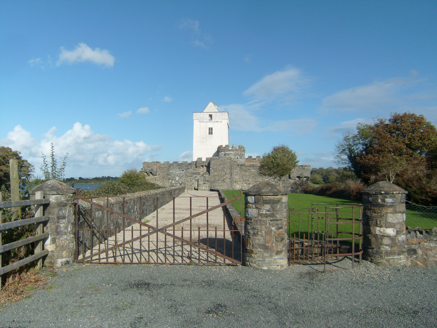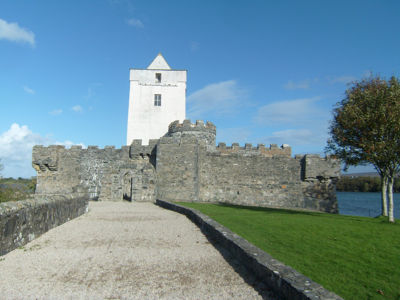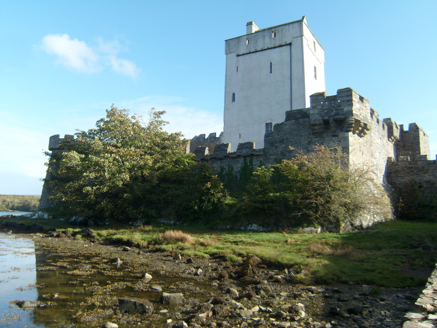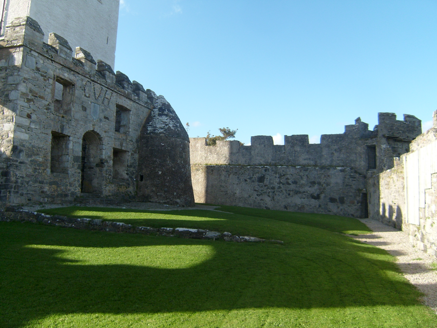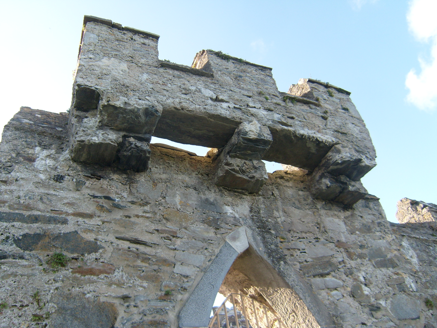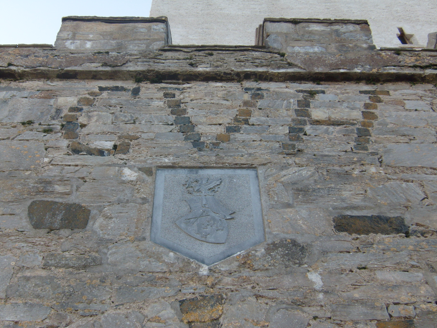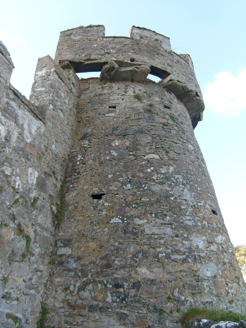Survey Data
Reg No
40902642
Rating
National
Categories of Special Interest
Archaeological, Architectural, Artistic
Original Use
Castle/fortified house
Date
1550 - 1830
Coordinates
208710, 431990
Date Recorded
08/04/2014
Date Updated
--/--/--
Description
Tower house and bawn, built in early sixteenth century, comprising moat and irregular bawn enclosing four-storey tower house with attic and two-stage casemate, altered c.1820 with addition of barbican to west, three-stage outer round-plan tower to northeast of bawn, round-plan tower of c.1820 to west of tower house, and remains of two two-storey buildings to east of tower house. Now ruinous and in care of Office of Public Works. Pitched slate roof to tower house with raised parapets having flat rendered copings and rendered chimneystack. Roughcast rendered walls with square-headed openings throughout, comprising loops and pair of trefoil-headed windows within square-headed opening to west at first floor level, and round-headed opening to south. Stone corbelled roof to casemate with remains of render to rubble stone walls, having loops to north and east. Rubble stone barbican to west with splayed sills to square-headed openings. Round tower to west of tower house has raised and crenellated parapet and loops throughout. Three-bay two-storey facade to east of tower house with crenellated parapet, square-headed window openings and central round-headed doorway with initials 'CVH' and coat of arms over doorway. Three-bay two-storey facade to south with large round-headed openings to first floor. Rubble stone bawn wall with crenellated parapet, corner bartizans and incorporating two-stage round tower of c.1820 to northeast, with machicolation and crenellated parapet, having loops throughout. Pointed-arch opening to west with machicolation over, and lancet opening to east. Remains of ravelin of c.1780 in rubble and earth to east. Overlooks Sheephaven Bay to north, south and east, with graveyard to southwest where MacSuibhne (MacSweeny) chieftains were buried.
Appraisal
Doe Castle is an impressive, picturesque ruin of considerable archaeological, historical and architectural importance. It was built by the Quin Family and then passed to the Mac Sweenys of Tuatha, becoming the latter's chief seat. It was also the place where Owen Roe O’Neill was welcomed on his return to Ireland in 1642. The castle was captured by Charles Coote from the Cromwellians in 1650. Finally, it was purchased by Captain George Vaughan Hart of Kilderry House, Muff, whose arms are set over the door of the building east of the tower house. Hart carried out various alterations in the early nineteenth century, including extensions to the tower house, the barbican and the round tower to the northeast of the bawn. The castle is a striking landscape feature, situated in a prominent location on the shores of Sheephaven Bay, and can be seen when travelling from Creeslough to Carrickart. The castle presents some fine architectural detailing, in particular the crenellated parapets, bartizans and machicolations to the bawn wall. Coupled with its archaeological significance, Doe Castle has significant historical value at a national level.
